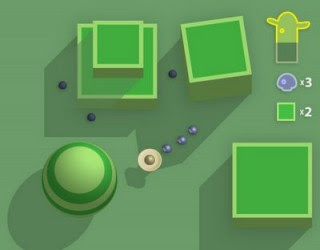Lost Garden is one of my preferred blogs. The owner, Danc, always posts interesting articles about game design and also provides nice 2D graphics to developers who want to prototype his designs. From time to time, Danc also launches game prototyping challenges and assigns virtual bronze, silver and gold awards to the best works.
Now it's the time of Shade, the latest game prototyping challenge, the first that is not designed exclusively for 2D, in fact shadows play an important role in the game.
Now it's the time of Shade, the latest game prototyping challenge, the first that is not designed exclusively for 2D, in fact shadows play an important role in the game.

Since the game is based from the beginning on a 3D environment, I can finally develop a prototype based on APOCALYX, instead of my less powerful TooDee engine. As you can read in the article that describes the game, all the necessary features are already available. Shade needs a flat terrain, a simple HUD, several moving objects (the player avatar, the mushrooms etc.) and blocks that cast shadows. Since APOCALYX is completely scripted, it's the perfect tool to develop a fast game prototype: a challenge that one has no excuses to refuse.
Danc describes the basic gameplay as follows: "You play the part of a rugged mushroom rancher who must collect adorable sentient mushrooms living in the shade. All you need to do is run up to a planted mushroom and touch it. It will pop out of the ground and start following you around. Lead it back to the start location and you'll be awarded multiple point based off its size.
Unfortunately, it is a scorchingly hot day. You can meander about the landscape of giant grassy blocks with impunity due to your meglo-awesome wide brimmed hat, but the mushrooms wilt quickly in sunlight. To lead them back successfully, you'll need to keep to the shadows and plot the optimal path home."
For more details, read the complete article at Lost Garden.
Danc describes the basic gameplay as follows: "You play the part of a rugged mushroom rancher who must collect adorable sentient mushrooms living in the shade. All you need to do is run up to a planted mushroom and touch it. It will pop out of the ground and start following you around. Lead it back to the start location and you'll be awarded multiple point based off its size.
Unfortunately, it is a scorchingly hot day. You can meander about the landscape of giant grassy blocks with impunity due to your meglo-awesome wide brimmed hat, but the mushrooms wilt quickly in sunlight. To lead them back successfully, you'll need to keep to the shadows and plot the optimal path home."
For more details, read the complete article at Lost Garden.








 A description of the modifications:
A description of the modifications:










 For example, there are several functions that control the movement of the bot, such as: SetWalkSpeed(), SetStrafeSpeed(), SetRotationSpeed(), Jump() and Dive(). Then there is an important action, Kick(), and several functions to communicate with the teammates. Finally, there are a lot of input functions, like GetBallPosition(), GetPlayerPosition() and others, that are absolutely necessary to the bots to be aware of the sorrouding environment.
For example, there are several functions that control the movement of the bot, such as: SetWalkSpeed(), SetStrafeSpeed(), SetRotationSpeed(), Jump() and Dive(). Then there is an important action, Kick(), and several functions to communicate with the teammates. Finally, there are a lot of input functions, like GetBallPosition(), GetPlayerPosition() and others, that are absolutely necessary to the bots to be aware of the sorrouding environment.




















